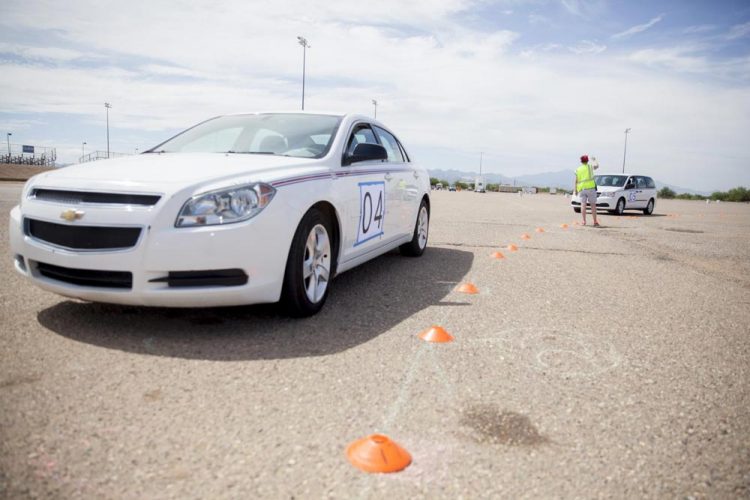Experiments show that a few self-driving cars can dramatically improve traffic flow

According to Daniel Work, assistant professor of civil environmental engineering at the University of Illinois, The use of autonomous vehicles to regulate traffic flow is the next innovation in the rapidly evolving science of traffic monitoring and control. Credit: John de Dios
“Our experiments show that with as few as 5 percent of vehicles being automated and carefully controlled, we can eliminate stop-and-go waves caused by human driving behavior,” said Daniel B. Work, assistant professor at the University of Illinois at Urbana-Champaign, a lead researcher in the study.
The use of autonomous vehicles to regulate traffic flow is the next innovation in the rapidly evolving science of traffic monitoring and control, Work said. Just as fixed traffic sensors have been replaced by crowd-sourced GPS data in many navigation systems, the use of self-driving cars is poised to replace classical freeway traffic control concepts like variable speed limits. Critical to the success of this innovation is a deeper understanding of the dynamic between these autonomous vehicles and the human drivers on the road.
Funded by the National Science Foundation's Cyber-Physical Systems program, the research was led by a multi-disciplinary team of researchers with expertise in traffic flow theory, control theory, robotics, cyber-physical systems, and transportation engineering. Principal investigators (PIs) were: Benedetto Piccoli, the Joseph and Loretta Lopez Chair Professor of Mathematics at Rutgers University, Camden; Benjamin Seibold, associate professor of Mathematics at Temple University; Jonathan Sprinkle, the Litton Industries John M. Leonis Distinguished Associate Professor in Electrical and Computer Engineering at the University of Arizona, Tucson; and Daniel B. Work, assistant professor in Civil and Environmental Engineering and the Coordinated Science Laboratory at the University of Illinois at Urbana-Champaign.
The team conducted field experiments in Tucson, Arizona, in which a single autonomous vehicle circled a track continuously with at least 20 other human-driven cars. Under normal circumstances, human drivers naturally create stop-and-go traffic, even in the absence of bottlenecks, lane changes, merges or other disruptions, Work said. This phenomenon is called the “phantom traffic jam.” Researchers found that by controlling the pace of the autonomous car in the study, they were able to smooth out the traffic flow for all the cars. For the first time, researchers demonstrated experimentally that even a small percentage of such vehicles can have a significant impact on the road, eliminating waves and reducing the total fuel consumption by up to 40 percent. Moreover, the researchers found that conceptually simple and easy to implement control strategies can achieve the goal.
“Before we carried out these experiments, I did not know how straightforward it could be to positively affect the flow of traffic,” Sprinkle said. “I assumed we would need sophisticated control techniques, but what we showed was that controllers which are staples of undergraduate control theory will do the trick.”
This latest research suggests that even the related technology available now – such as adaptive cruise control – has the power to improve traffic even before there are large numbers of autonomous vehicles on the road.
“Fully autonomous vehicles in common traffic may be still far away in the future due to many technological, market and policy constraints,” Piccoli said. “However, increased communication among vehicles and increased levels of autonomy in human-driven vehicles is in the near future.”
The near future with only a few autonomous vehicles on the road is more challenging than the far future in which all vehicles are connected, Seibold said.
“The proper design of autonomous vehicles requires a profound understanding of the reaction of humans to them,” Seibold said, “and traffic experiments play a crucial role in understanding this interplay of human and robotic agents.”
The researchers say the next step will be to study the impact of autonomous vehicles in denser traffic with more freedom granted to the human drivers, such as the ability to change lanes.
Media Contact
All latest news from the category: Transportation and Logistics
This field deals with all spatial and time-related activities involved in bridging the gap between goods and people, including their restructuring. This begins with the supplier and follows each stage of the operational value chain to product delivery and concludes with product disposal and recycling.
innovations-report provides informative reports and articles on such topics as traffic telematics, toll collection, traffic management systems, route planning, high-speed rail (Transrapid), traffic infrastructures, air safety, transport technologies, transport logistics, production logistics and mobility.
Newest articles

Silicon Carbide Innovation Alliance to drive industrial-scale semiconductor work
Known for its ability to withstand extreme environments and high voltages, silicon carbide (SiC) is a semiconducting material made up of silicon and carbon atoms arranged into crystals that is…

New SPECT/CT technique shows impressive biomarker identification
…offers increased access for prostate cancer patients. A novel SPECT/CT acquisition method can accurately detect radiopharmaceutical biodistribution in a convenient manner for prostate cancer patients, opening the door for more…

How 3D printers can give robots a soft touch
Soft skin coverings and touch sensors have emerged as a promising feature for robots that are both safer and more intuitive for human interaction, but they are expensive and difficult…





















